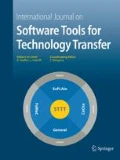Abstract
We introduce CESRBDDs, a form of binary decision diagrams (BDDs) that can exploit reduction opportunities beyond those allowed by reduced ordered BDDs (elimination of redundant nodes), zero-suppressed BDDs (elimination of “high-zero” nodes), and recent proposals merging the two (chained or tagged BDDs). CESRBDDs also incorporate complemented edges, thus never store both the encoding of a function and of its complement. We prove that CESRBDDs are canonical and show how their storage requirements and computational efficiency compare very favorably against previous alternatives, both theoretically and experimentally, using an extensive set of benchmarks. Another advantage of CESRBDDs over chained or tagged BDDs is that their nodes only require one byte to store reduction and complement information.






Similar content being viewed by others
References
Akers, S.B.: Functional testing using binary decision diagrams. In: Proceedings of 8th International Symposium on Fault-Tolerant Computing, pp. 75–82 (1978)
Amparore, E., Donatelli, S., Ciardo, G., Miner, A.: \(i_{{\rm Rank}}\): a variable order metric for DEDS subject to linear invariants. In: Vojnar, T., Zhang L. (eds.) Proceedings of TACAS, LNCS, vol. 11428, pp. 285–302. Springer, Prague (2019)
Babar, J.: Decision diagrams: extensions and applications to reachability analysis. Ph.D. thesis, Iowa State University (2019)
Babar, J., Jiang, C., Ciardo, G., Miner, A.: Binary decision diagrams with edge-specified reductions. In: Vojnar, T., Zhang, L. (eds.) Proceedings of TACAS, LNCS, vol. 11428, pp. 303–318. Springer, Prague (2019)
Bryant, R.E.: Graph-based algorithms for boolean function manipulation. IEEE Trans. Comput. 35(8), 677–691 (1986)
Bryant, R.E.: Chain reduction for binary and zero-suppressed decision diagrams. In: Beyer, D., Huisman, M. (eds.) Tools and Algorithms for the Construction and Analysis of Systems, pp. 81–98. Springer, Cham (2018)
Denzumi, S., Kawahara, J., Tsuda, K., Arimura, H., Minato, S., Sadakane, K.: Densezdd: a compact and fast index for families of sets. Algorithms 11, 128 (2018)
Drechsler, R., Becker, B.: Ordered Kronecker functional decision diagrams—a data structure for representation and manipulation of boolean functions. Trans. Comput. Integr. Circuits Syst. 17(10), 965–973 (2006). https://doi.org/10.1109/43.728917
Fleming, P.J., Wallace, J.J.: How not to lie with statistics: the correct way to summarize benchmark results. Commun. ACM 29(3), 218–221 (1986). https://doi.org/10.1145/5666.5673
Karplus, K.: Representing boolean functions with if-then-else DAGs. University of California at Santa Cruz, Santa Cruz, CA, USA, Tech. rep. (1988)
Kimura, S., Clarke, E.M.: A parallel algorithm for constructing binary decision diagrams. In: Proc. Int. Conf. on Computer Design (ICCD), pp. 220–223. IEEE Comp. Soc. Press (1990)
Knuth, D.E.: The Art of Computer Programming, Volume 4A: Combinatorial Algorithms, Part I. Addison-Wesley (2011)
Lee, C.Y.: Representation of switching circuits by binary-decision programs. Bell Syst. Technol. J. 38(4), 985–999 (1959)
Madre, J.C., Billon, J.P.: Proving circuit correctness using formal comparison between expected and extracted behaviour. In: Proceedings of 25th ACM/IEEE Design Automation Conference, DAC ’88, pp. 205–210. IEEE Computer Society Press, Los Alamitos (1988)
Miessler, D., Haddix, J.: SecLists. https://github.com/danielmiessler/SecLists
Minato, S.: Binary Decision Diagrams and Their Applications for VLSI CAD. Ph.D. thesis, Kyoto University (1995)
Minato, S.: Zero-suppressed BDDs and their applications. Softw. Tools Technol. Transf. 3, 156–170 (2001)
Rudell, R.: Dynamic variable ordering for ordered binary decision diagrams. In: International Conference on CAD, pp. 139–144 (1993)
van Dijk, T., Wille, R., Meolic, R.: Tagged BDDs: combining reduction rules from different decision diagram types. In: Proceedings of the 17th Conference on Formal Methods in Computer-Aided Design, FMCAD ’17, pp. 108–115. FMCAD Inc, Austin, TX (2017). http://dl.acm.org/citation.cfm?id=3168451.3168478
Yang, S.: Logic synthesis and optimization benchmarks user guide: version 3.0. Microelectronics Center of North Carolina (MCNC) (1991)
Author information
Authors and Affiliations
Corresponding author
Additional information
Publisher's Note
Springer Nature remains neutral with regard to jurisdictional claims in published maps and institutional affiliations.
This work was supported in part by National Science Foundation Grant ACI-1642397.
Rights and permissions
About this article
Cite this article
Babar, J., Ciardo, G. & Miner, A. CESRBDDs: binary decision diagrams with complemented edges and edge-specified reductions. Int J Softw Tools Technol Transfer 24, 89–109 (2022). https://doi.org/10.1007/s10009-021-00640-0
Accepted:
Published:
Issue Date:
DOI: https://doi.org/10.1007/s10009-021-00640-0




